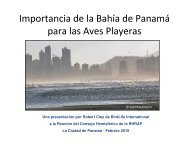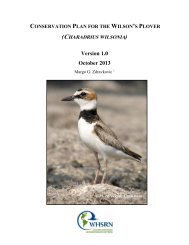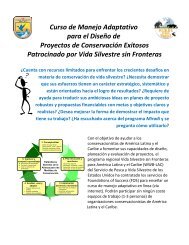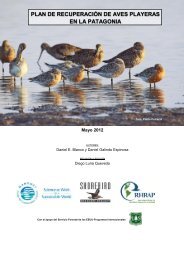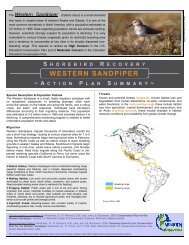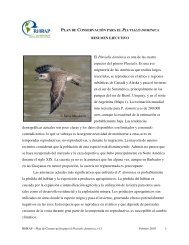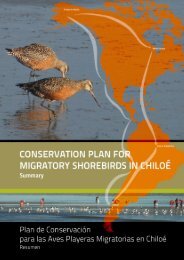Sanderling Plan - Western Hemisphere Shorebird Reserve Network
Sanderling Plan - Western Hemisphere Shorebird Reserve Network
Sanderling Plan - Western Hemisphere Shorebird Reserve Network
Create successful ePaper yourself
Turn your PDF publications into a flip-book with our unique Google optimized e-Paper software.
A potential issue of importance on the North American Pacific Coast (Washington,<br />
Oregon, and parts of California) is the rate at which <strong>Sanderling</strong>s acquire their essential food<br />
intake during winter, when storms can last several days or more and limit (or even prevent)<br />
foraging by <strong>Sanderling</strong>s. How does food intake vary with weather? If stormy conditions pose a<br />
significant constraint to <strong>Sanderling</strong> mass accumulation, the need to manage human disturbance<br />
would increase, given its potentially compounding effect on <strong>Sanderling</strong> survival (during stressful<br />
conditions).<br />
DANGERS (POTENTIAL AND KNOWN):<br />
Research is needed to illuminate the current and potential dangers to <strong>Sanderling</strong><br />
populations, with the explicit purpose of clarifying the actual threat and reducing those threats:<br />
Habitat alteration<br />
o Determine the effects of habitat alterations such dredging, beach replenishment, and other<br />
activities;<br />
o Identify factors that may limit the quality of stopover habitat<br />
Contaminants<br />
o Determine the effects of contaminants on <strong>Sanderling</strong> prey;<br />
o Determine the effects of contaminants on <strong>Sanderling</strong> and other shorebirds;<br />
o Examination of sublethal effects of pesticide and other contamination on migratory<br />
performance.<br />
Oil spills<br />
o Monitor/quantify habitat and food resources prior to spill as preparation for quantifying<br />
the direct and indirect effects of spills;<br />
o Conduct post-spill surveys to accurately quantify spill damages;<br />
o Improve oil trajectory models;<br />
o Effect of oiling on the duration of migratory stopovers, likelihood of disruption or<br />
cessation of further migration, mortality during migration, and reproduction.<br />
o Physiological effects on <strong>Sanderling</strong>s and other shorebirds from ingesting oil products<br />
while preening after being contaminated from a spill.<br />
WHSRN – <strong>Sanderling</strong> Conservation <strong>Plan</strong>, February 2010, v1.1 60




